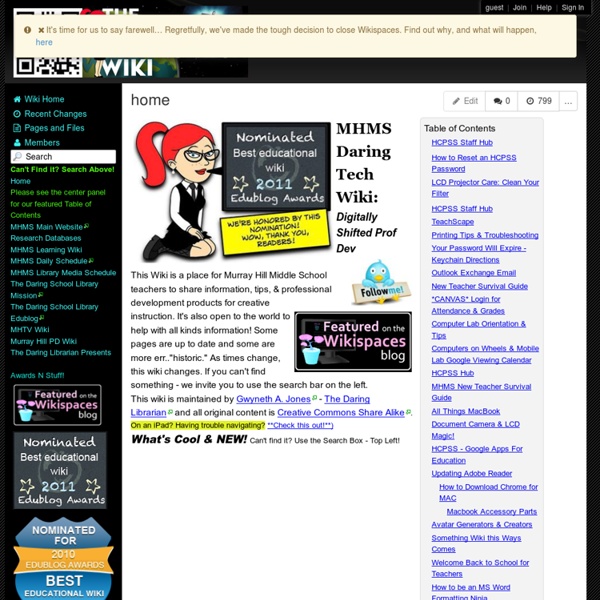



digitalgoonies.com Home - Doug Johnson's Blue Skunk Blog joyce-valenza.wikispaces "A content curator" is "someone who continually finds, groups, organizes and shares the best and most relevant content on a specific issue online" (Bhargava, 2009, para. 4). With this in mind, content curation is digital archiving. This model is classified into five subgroups:Aggregation. The act of curating the most relevant information about a particular topic into a single location;Distillation. Key Implications of Curation Tools for 21st Century School Libraries Curation tools are important in school libraries because they lessen the possibility of information overload while providing concrete examples of synthesized information. Key Implications for Implementing Guided Inquiry With Curation Tools Curation websites are useful to students during the collection stage of the ISP because they can access varied information formats from multiple sources in one webpage.
New Stephen's Lighthouse Curation School Library Monthly/Volume XXIX, Number 1/September-October 2012 Curation by Joyce Kasman Valenza Joyce Kasman Valenza, Ph.D., is a teacher librarian at Springfield Township High School in Erdenheim, PA. Email: joycevalenza@gmail.com The Internet firehose analogy rings even truer today, twenty years after Internet access saw its beginning. Human Filters Help Digital curators can prevent oversaturation by filtering and diverting the onslaught and by directing what is worth sharing into more gentle and continuous streams. Blogger, author, and NYU professor Clay Shirky, in Steve Rosebaum’s Mashable post, "Why Content Curation Is Here to Stay" on May 10, 2010, describes the problem with traditional search and identifies the issue of filter failure: Curation comes up when search stops working. Human filters make a difference. Curators make sense of the vast amounts of content that are continually produced. Perhaps Albert Barnes was the ultimate curator for the pre-digital world. Conclusion
The Library Voice Best Websites for Teaching & Learning The Landmark Websites are honored due to their exemplary histories of authoritative, dynamic content and curricular relevance. They are free, web-based sites that are user friendly and encourage a community of learners to explore and discover and provide a foundation to support 21st-century teaching and learning. Guidelines for School Library Programs: Instructional Partner "The SLMS collaborates with classroom teachers to develop assignments that are matched to academic standards and include critical thinking skills, technology and information literacy skills, and core social skills and cultural competencies. Content Resources, Lesson Plans, and More Empower learners of all types and ages. Tip: Take a look at all the ALTEC Star Tools. Annenberg Media Learner.Org Videos, interactives, workshops, and distance learning are all available on this site. Tip: Browse by grade to find awesome classroom and lesson ideas. ASCD (Association of Supervision and Curriculum Development) Edutopia EduWeb
AudioSynced In conjunction with Abby (the) Librarian, STACKED hosts a monthly meme to celebrate all things audiobook. On the first of each month, we rotate the blogger round up of audiobook news, reviews, and more shared in the blogosphere in the last month. We host on odd-numbered months. To participate, share a link to your audiobook reviews, news, or features from the previous month (so, for June 1st, share anything posted between May 1 and June 1). If you are a publisher of audiobooks or write about them for publication, get in touch. Want to promote this meme? Check out the AudioSynced archives for ideas of what we're looking for or to become inspired for your own posts: 2010 AudioSynced 2011 AudioSynced 2012 AudioSynced 2013 AudioSynced ShareThisContinue reading... Technology An amazing way to get your tweens and teens to know the “unfamiliar” bits of your library is to do self-directed scavenger hunts. You know that your “kids” tend to congregate to one particular area- whether it’s your teen space, a place with the most comfortable chairs or a low table for card gaming, or the place furthest away from the supervising eyes of the non-teen people at the desk. And while they’ll know where to find the YA books, MAD Magazine and Alternative Press, and manga, do they know where to find non-fiction books for reports? Or how to operate one of the databases? If you become devious and take a little time out of your day, you can take a theme and turn a lesson in the library world into a creative self-directed program that will make them want to participate. Scavenger hunts can be as intricate or as simple as you want them to be. Once you have your theme, decide on the length of the hunt. So get creative and then sit back and watch the fun!
School Library Monthly Blog